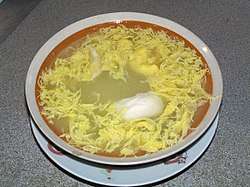Tong sui
Tong sui (literally translated as "sugar water"), also known as tim tong, is a collective term for any sweet, warm soup or custard served as a dessert at the end of a meal in Cantonese cuisine.[1] Tong sui are a Cantonese specialty and many varieties are rarely found in other regional cuisines of China.[2] Outside of Cantonese-speaking communities, soupy desserts generally are not recognized as a distinct category, and the term tong sui is not used.
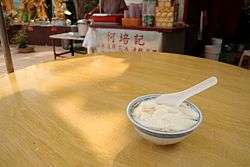 Tofu tong sui at 10,000 Buddhas Monastery | |
| Type | Soup or custard |
|---|---|
| Course | Dessert |
| Place of origin | China |
| Tong sui | |||||||||||||||
|---|---|---|---|---|---|---|---|---|---|---|---|---|---|---|---|
| Chinese | 糖水 | ||||||||||||||
| Literal meaning | sugar water | ||||||||||||||
| |||||||||||||||
| Tian tang | |||||||||||||||
| Chinese | 甜湯 | ||||||||||||||
| Literal meaning | sweet soup | ||||||||||||||
| |||||||||||||||
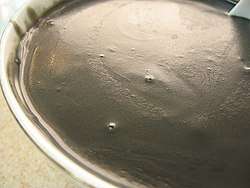
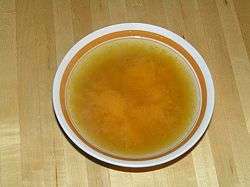
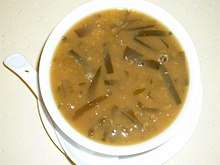
In Hong Kong, Macao and Malaysia, a large variety of tong sui is served in tong sui specialty stores. Tong sui stores have also gained prominence in overseas Chinese communities, and are found in various parts of Canada, Australia and the United States.
History
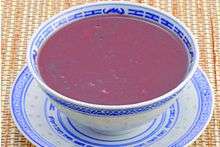
Tong sui shops in Hong Kong mainly originated from the postwar period. Chinese migrants brought their hometown sweet soups to Hong Kong, such as red bean soup from Guangzhou and tang yuan from Shanghai. Newcomers sold tong sui in newly-opened street side food stalls and Chinese tea house.
During the 1980s to 1990s, Hong Kong’s economy developed rapidly and living standards rose. Western desserts and sweet soups were imported to Hong Kong by Western hotels or cooks who had studied in the West. Under Western influence, people started using fresh fruits to create new-style tong sui such as tapioca pudding. Many Chinese herbal tea shops like Hui Lau Shan transformed into tong sui shops.[3]
In the 21st century, chain tong sui shops have become more prominent and recommended as tourist attractions by The Hong Kong Tourism Board.
Traditional tong sui
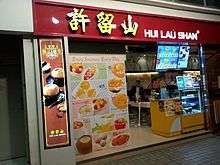
Historically, the basic ingredients of traditional sweet soups are beans, milk, and fruits.[4] The desserts and sweet soups provided in the menus of the traditional tong sui shops are mainly the Chinese-style sweet soups. Staples like red bean soup and sweet almond soup are common types of sweet soups sold in the ordinary tong sui shops.[5]
Common varieties
| English name | Chinese name | Description |
|---|---|---|
| Black sesame soup | 芝麻糊; zi1 maa4 wu4*2 | Ground black sesame seeds are traditionally cooked with water and rock sugar. Chinese herbs are sometimes added to enhance the flavor and aroma. The instant black sesame powder sold in Asian supermarkets is usually sweetened. It requires the addition of hot water and mixing in the serving bowl, after which it should be left for 15 minutes before serving. |
| Doufuhua[6] | 豆花; dòuhuā or 豆腐花; dau6 fu6 faa1 | Tofu pudding, add a small amount of salt or gypsum condensed into soy milk to form a more tender semi-liquid tofu with sweet syrup served in a separate bowl |
| Egg tong sui | 鸡蛋糖水; 雞蛋糖水; gai1 daan2 tong4 seoi2 | popular in Hong Kong and southern China |
| Got fan soup | 葛粉汤; 葛粉湯; got3 fan2 tong1 | kudzu soup |
| Guilinggao | 龜苓膏; gwai1 ling4 gou1 | made from three-lined box turtle |
| Hasma | 雪蛤; syut3 gaap3 | A dessert made of dried fallopian tubes of the frog with supposed health benefits. |
| Purple rice porridge | 紫米露; zi2 mai5 lou6 | A dessert made of thick boiled black rice mixed with coconut juice. Sago, red beans, and taro are often added on top. |
| Red bean soup, Red bean paste | 红豆汤; 紅豆湯; hóngdòu tāng or 红豆沙; 紅豆沙; hung4 dau2 saa1 | Cooked and served exactly like mung bean soup & paste. Red bean soup is normally pre-boiled to soften the skin by leaving in hot water for one hour. Then cook in water for 20–30 minutes until the beans rupture. The adding of sugar or rock sugar is lastly added to cook for another 20–30 minutes until the bean texture becomes sandy. As for red bean paste, the skin is removed before cooking. Chinese herbs may be added to enhance the flavor and taste. |
| Sai mai lo or Sago | 西米露; sai1 mai5 lou6 | A dessert soup of pearl tapioca, coconut and evaporated milk |
| Mung bean soup | 绿豆汤; 綠豆湯; lǜdòu tāng or 绿豆沙; 綠豆沙; luk6 dau6 saa1 | Made from mung beans and cooked exactly like red bean soup/paste, sometimes also served with seaweed |
| Six flavors soup | 六味汤; 六味湯; liùwèi tāng | A sweet curative soup made for hot summer, one of many "numbered" medicinal soups |
| Peanut paste soup | 花生糊; huāshēng hú | Like black sesame paste, peanut paste is a ground peanut powder cooked with syrup and water. Instant peanut paste powder sold in Asian supermarket are usually sweetened roasted peanut powder or flour, that only required to be served with hot water. |
| Steamed egg custard | 炖蛋; 燉蛋; dan6 daan2 | |
| Steamed milk custard | 炖奶; 燉奶; dan6 naai5 | |
| Sweet potato soup | 番薯糖水; faan1 syu4 tong4 seoi2 | Peeled sweet potato, normally cut into smaller pieces cooked/ boiled with syrup and water. |
| Sweet almond soup | 杏仁糊; hang6 jan4 wu4 | Ground almond powder that cooked with sugar and water. Instant almond powder sold in Asian supermarket are usually sweetened raw almond flour or powder, requires minimal cooking with boiling water or to be served after mixing with hot water for 15 minutes. |
| Sweet walnut soup | 核桃糊; hat6 tou4 wu4 or 合桃糊; hap6 tou4 wu4 | Ground walnut powder that cooked with sugar and water, sometimes milk. Similar to Sweet almond soup, instant walnut powder is sold in Asian supermarket as well. |
| Tofu skin egg tong sui | 腐竹鸡蛋糖水; 腐竹雞蛋糖水; fu6 zuk1 gai1 daan2 tong4 seoi2 | Made of four ingredients: tofu skin, eggs, sugar and water. Soften the dry tofu skin by soaking it in water first, boil it with sugar and water, add boiled eggs before serving. Sometimes, boiled ginkgo nuts are added. |
See also
Sources
- So Good Blog. "Hong Kong: the Sugar Land of Sweet Soup (Tong Sui)." Wenna Pang. Retrieved 2017-06-07.
- "Tong Sui: A Dessert That Has No End". Traveler Door. 2020-06-08. Retrieved 2020-06-08.
- Dessert chain offers place to chill out. South China Morning Post. Retrieved 24/3/2014
- 感受舌尖上的溫暖 香港糖水的'甜秘密'. Chinanews. Retrieved 24/3/2014 Archived 2014-03-25 at the Wayback Machine
- 新舊糖水舖 左右互搏生意經. The Sun. Retrieved 19/3/2014
- dict.concised.moe.edu.tw http://dict.concised.moe.edu.tw/cgi-bin/jbdic/gsweb.cgi?o=djbdic&searchid=Z00000007815. Retrieved 2019-11-19. Missing or empty
|title=(help)
External links
| Wikimedia Commons has media related to Sugar water. |
